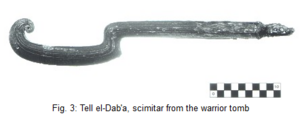
FAIR is a non-profit organization dedicated to providing well-documented answers to criticisms of the doctrine, practice, and history of The Church of Jesus Christ of Latter-day Saints.
No edit summary |
No edit summary |
||
| Line 13: | Line 13: | ||
|link=Book of Mormon/Warfare/Weapons/Swords | |link=Book of Mormon/Warfare/Weapons/Swords | ||
|subject=Swords | |subject=Swords | ||
|summary= | |||
}} | |||
{{SummaryItem | |||
|link=Book of Mormon/Warfare/Weapons/Cimeters | |||
|subject=Cimeters/Scimiters | |||
|summary= | |summary= | ||
}} | }} | ||
The Book of Mormon mentions the sword 156 times, more than any other weapon. For the sake of discussion, we have divided its usage into two categories: literary or metaphorical and military-technical. We have classified seventy-eight instances as metaphorical and seventy-eight as technical (though many occurrences are ambiguous and could fall in either category). There are four major types of sword metaphors used in the Book of Mormon: fighting or warfare in general, violent death, military vigilance, and divine power. The book metaphorically describes fighting in battle with eighteen different sword phrases, violent death with seven major metaphors, military preparedness with two phrases, and divine power with five metaphors.
Some critics have termed the presence of scimitars in the text of the Book of Mormon anachronistic. They base their claim on the mistaken assumption that scimitars did not exist in the pre-Islamic Old World and therefore could not have appeared among Book of Mormon peoples who claim an Old World nexus with Iron Age II Palestine.3 This assumption is based no doubt on one or more of the following considerations: (1) the scimitar is not mentioned earlier than the sixteenth century in English texts;4 (2) the Persian word samsir probably provided the etymon for the English word;5 and (3) the mistaken assumption that the period from A.D. 1000 to 1200 saw the "perfection of the Moslem scimitar."6 None of these observations asserts the presence or absence of scimitars in pre-Islamic times. Any arguments to the contrary based on these observations are simply arguments from silence and in this case would result in false conclusions.
There can be no question that scimitars, or sickle swords, were known in the ancient Near East during the Late Bronze Period, that is, about six hundred years prior to Lehi's departure from Jerusalem. There have been several early attempts to demonstrate this,7 but more recently Brent Merrill has convincingly shown that scimitars existed in the Late Bronze Age.8 In addition to the sources Merrill cited, Othmar Keel, on the basis of artifactual and glyptic evidence, dated the use of the scimitar as a weapon in the ancient Near East from 2400 to 1150 B.C., just a little after the traditional 1200 B.C. closing date for the Late Bronze Age.9 Robert Macalister found a late Bronze Age sickle sword at Gezer in Palestine (together with a Mycenaean pot), which Maxwell Hyslop dated to the "14th century B.c."10 Yigael Yadin discussed such swords in the context of warfare in the Near East, including the curved sword in use from Egypt to Assyria during the Late Bronze Age.11. [1] —(Click here to continue)

An Egyptian excavation described a "scimeter," with a picture so labeled:
Matthew Roper: [4]
The possibility has been suggested that a strange double-curved weapon held in the left hand of the warrior figure on the Loltún cave relief might be considered a scimitar/cimeter.[5] Its two blades curve in opposite directions from the ends of a central handle. Grube and Schele consider the object to be a weapon, and it looks something like a special version of the short-sword discussed above. We recall that the date for the figure at Loltún falls within the Book of Mormon period. Moreover, the Izapan art style in which the figure is carved originated in Pacific coastal Guatemala or southern Mexico. That region includes the territory thought by most Latter-day Saint researchers to have been the Nephite and Lamanite heartland. Thus the weapon shown at Loltún has a good chance of being one of the arms that Lamanites and Nephites were using during the central segment of Book of Mormon history. In fact, at Kaminaljuyu, the great ruined city in the valley of Guatemala, which many consider to have been the city of Nephi (or Lehi-Nephi), Stela 11 shows a warrior figure holding a curved object similar to that on the Loltún portrait. It may be even earlier than the one at Loltún, dating to the early Miraflores period (250 to 100 BC). Some Mesoamerican experts consider that the curved object on Stela 11 was the equivalent of the double-bladed weapon at Loltún.[6]
After the sword, the bow is the second most frequently mentioned weapon in the Book of Mormon. Bows are mentioned twenty-two times, arrows twenty-six. In fourteen cases the bow and arrow are mentioned together; in eight cases, the bow is mentioned alone; in twelve, the arrow alone. In most cases, the bow is simply mentioned as a weapon with no additional details. However, several significant incidents give some indication of the nature and use of the Book of Mormon bow.

FAIR is a non-profit organization dedicated to providing well-documented answers to criticisms of the doctrine, practice, and history of The Church of Jesus Christ of Latter-day Saints.
We are a volunteer organization. We invite you to give back.
Donate Now